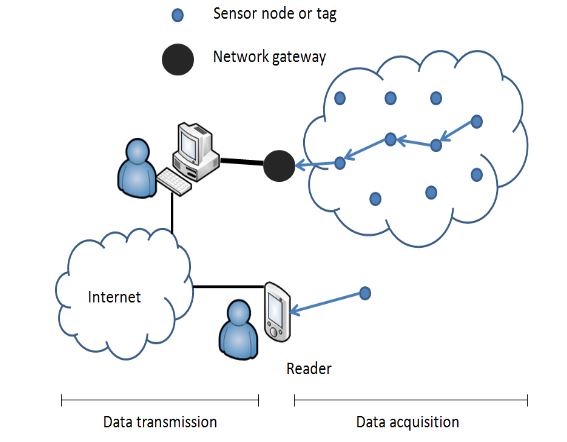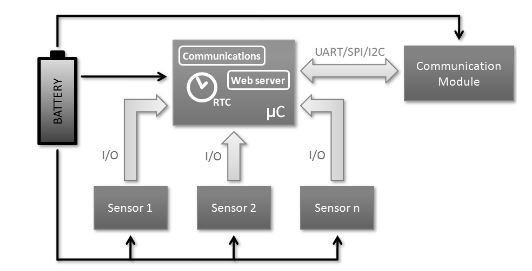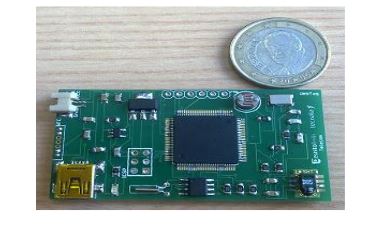ABSTRACT
Information and Communication Technologies (ICTs) continue to overcome many of the challenges related to wireless sensor monitoring, such as for example the design of smarter embedded processors, the improvement of the network architectures, the development of efficient communication protocols or the maximization of the life cycle autonomy. This work tries to improve the communication link of the data transmission in wireless sensor monitoring.
The upstream communication link is usually based on standard IP technologies, but the downstream side is always masked with the proprietary protocols used for the wireless link (like ZigBee, Bluetooth, RFID, etc.). This work presents a novel solution (WebTag) for a direct IP based access to a sensor tag over the Near Field Communication (NFC) technology for secure applications. WebTag allows a direct web access to the sensor tag by means of a standard web browser, it reads the sensor data, configures the sampling rate and implements IP based security policies. It is, definitely, a new step towards the evolution of the Internet of Things paradigm.
ACCESS MODES OF SENSOR WIRELESS MONITORING

Figure 1. Remote and near field access modes
In both cases, the communication process can be divided in to two main stages: the former (on the right side of the Figure 1) is carried out when the data is transmitted from the sensor tag to the reader or the network gateway (let’s define it as data acquisition), depending on the access mode. The latter, is done when data is sent upstream from the reader or the gateway node to an upper decision making system or to the Internet (let’s call it data transmission).
WEBTAG

Figure 3. WebTag architecture
The WebTag architecture (see Figure 3) does not differ much from the rest of existing sensor tags. The microcontroller is the head of the device, it controls the basic decisions like when do the measurement, where store the data, when do the transmission and what type of logic or arithmetic operation should be applied.
IMPLEMENTATION AND EVALUATION

Figure 4. WebTag
The current WebTag prototype (Figure 4) is based on the ATmega2560 chip (256 KB of flash memory and 8 KB of RAM) with the Arduino bootloader built in it. The prototype has 2 sides: upper side has the chip, the battery connector, the USB-battery charger circuit, the set of sensors and the hardware RTC chip. The bottom side has the NFC chip (NXP PN532), the matching circuit and the antenna. The microcontroller is connected through a pin head to the NFC reader.

Figure 6. Authentication process
The WebTag prototype also implements a login access control service in order to avoid any external user to access the information within the web server (Figure 6). If the username and password are not properly introduced in a configurable number of attempts, the system will not allow connections for a time and will set a warning flag in memory with the time and date of the failed access attempt to be reported when the tag is surfed.
CONCLUSIONS
This paper introduces WebTag, a new concept of smart sensor tag s with web access. It is based o n the near field (NFC) point-to-point technology over a micro embedded web server. It represents a step forward to the evolution of the Internet—from a simple inter-computer connection to an Internet of Things paradigm—applied to the wireless sensor monitoring for secure applications. WebTag tries to merge the advantages of the NFC and IP technologies, i.e., point-to-point and web access, creating a new access method for wireless sensor monitoring.
A TCP/IP enabled sensor allows a bidirectional data transfer whereby read and write operations are possible with standard web browsers, extending the number of readers to any device with that application inside. Moreover, all the capabilities available in the Internet are used by WebTag in order to increase the security of data transmission and to provide a user login. Unless WebTag has been validated in a near field point-to-point application, this is the first step to its integration in wireless sensor networks. This work shows the challenges of integrating a web access into a sensor tag.
On the one hand, we found some of the problems related with the low power requirements. All the hardware and software designs need to be optimized in power consumption, and the inclusion of web based communication technologies in low power microcontrollers has been solved successfully. On the other hand, the fact of providing a web access over radiofrequency identification technology has been a major challenge.
This is because NFC and TCP/IP differ in their basic way of functioning. TCP/IP is prepared for the exchange of large and constant amount of data, while NFC is prepared for small payloads, few exchanges and a master-slave model. Thus, enabling an acceptable TCP/IP tunnel over NFC in terms of latency, number of exchanges and memory usage has been fulfilledal so successfully.
Source: University of Deusto
Authors: Juan Jose Echevarria | Jonathan Ruiz-de-Garibay | Jon Legarda | Maite Alvarez | Ana Ayerbe | Juan Ignacio Vazquez
>> More Wireless Projects using Arduino for Engineering Students
>> More Wireless Sensor Networks Projects Abstract for Engineering Students
>> Wireless Bluetooth Projects for Engineering Students
>> More Wireless Embedded Projects for Final Year Students